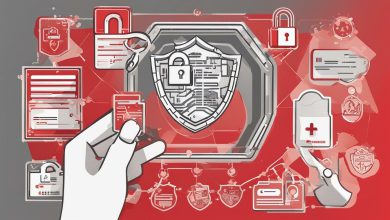
Welcome to our article on the Principles of Secure Coding, where we will explore the foundation of building robust and hack-proof software. As technology evolves, more and more industries are relying on technology to automate their processes. With this comes an increased risk of cyber threats, which can lead to data breaches, financial losses, and reputational damage. By following secure coding best practices and guidelines, developers can significantly enhance software security and mitigate risks.
In this section, we will delve into the essential principles of secure coding and explore how they can help developers build software that is resilient against potential attacks. Additionally, we will discuss common software vulnerabilities and the necessary coding security measures to mitigate them. By the end of this section, you will have a comprehensive understanding of the fundamentals of secure coding.
Key Takeaways
- Following secure coding best practices and guidelines is crucial for building robust and hack-proof software.
- Developers should stay updated with the latest software vulnerabilities and adopt coding security measures to mitigate risks effectively.
- A proactive approach to secure coding can help developers develop software that can withstand any cyber threat effectively and ensure the safety of user data and systems.
Secure Coding Best Practices
Developers have a crucial role in creating software that is robust, reliable, and secure. Implementing secure coding best practices is essential to ensure software security. By following secure coding guidelines, developers can protect their software against potential attacks and cyber threats.
Input Validation
Input validation is crucial in preventing attacks such as SQL injection and cross-site scripting. Developers should always validate user input before processing it in the software. Input validation involves checking user input for expected data types, formats, and lengths.
Secure Error Handling
Errors are an unavoidable part of any software development process. However, insecure error handling can lead to potential security breaches. Developers should implement secure error handling mechanisms that do not reveal sensitive information to users or attackers.
Proper Access Control
Implementing proper access control is essential to restrict unauthorized access to the software. Developers should ensure that only authenticated users have access to sensitive data and functionality. Role-based access control can also be implemented to grant access based on specific user roles.
Secure Configuration Management
Secure configuration management involves ensuring that the software is configured securely. This includes implementing secure default settings, encrypting sensitive data, and disabling unnecessary functionality. Regular security audits can also be performed to detect any vulnerabilities that may arise due to configuration changes.
Encryption Techniques
Encryption techniques can be used to protect sensitive data both in transit and at rest. Developers should implement encryption mechanisms such as SSL/TLS for secure communication and encryption algorithms such as AES for data encryption.
By adopting these secure coding best practices, developers can enhance software security and mitigate potential security risks.
Software Vulnerabilities and Threats
Developers must be aware of common software vulnerabilities and threats to build secure applications. These vulnerabilities can be exploited by attackers to access sensitive information or disrupt software operations. By understanding the following software vulnerabilities, developers can take necessary measures to mitigate risks and enhance software security.
Injection Attacks
Injection attacks are a type of software vulnerability that allows an attacker to insert malicious code into a software application through user input fields. These attacks can lead to the unauthorized access of sensitive data or the execution of unauthorized commands. To prevent injection attacks, developers must implement input validation and avoid using user input directly in SQL statements or command-line arguments.
Cross-Site Scripting (XSS)
XSS is another common vulnerability that allows an attacker to inject malicious scripts into a trusted website. This vulnerability can be exploited to steal user data, compromise user sessions, or redirect users to malicious websites. To prevent XSS attacks, developers must implement input validation and output encoding to prevent unauthorized code execution.
Insecure Direct Object References
Insecure direct object references occur when developers use object references to identify sensitive data or resources in a software application. Attackers can exploit this vulnerability by manipulating these references to access sensitive data or resources. To prevent insecure direct object references, developers must implement access controls and proper data validation to ensure the data and resources are only accessible to authorized users.
Protecting Sensitive Data
Developers must take necessary measures to protect sensitive data in software applications. This can be achieved by implementing data encryption, using secure password hashing, and ensuring proper access controls. Additionally, developers must avoid storing sensitive data in plain text files or databases that can be easily accessed by attackers.
Authentication and Authorization
Authentication and authorization are crucial components of software security. Developers must implement secure authentication mechanisms to verify user identities and prevent unauthorized access. Authorization controls must be used to ensure that only authorized users can access sensitive data or resources in the software application.
Security Misconfiguration
Security misconfiguration occurs when developers leave security settings in default or weak configurations. This can lead to unauthorized access to sensitive data or resources in the software application. To prevent security misconfigurations, developers must stay updated with the latest security patches and follow secure coding guidelines and practices.
By understanding these software vulnerabilities and threats, developers can take necessary measures to enhance software security. With proper software hardening, developers can ensure that software applications are resilient to cyber threats and protect user data and systems.
Coding Security Measures
Building secure software involves more than just following best practices and guidelines. Developers need to adopt coding security measures that harden their software against cyber attacks, protecting sensitive user data and the system as a whole.
Secure Coding Frameworks
One of the most effective coding security measures is the use of secure coding frameworks. These frameworks help developers build secure software by providing secure coding libraries and guidelines for secure coding practices. By leveraging the security expertise of these frameworks, developers can reduce the risk of security breaches and ensure the integrity of their software.
Secure Coding Analysis Tools
Secure coding analysis tools are another crucial coding security measure that developers can use to harden their software. These tools analyze software code and identify vulnerabilities and weaknesses that could be exploited by hackers. By using these tools, developers can detect and address security risks early in the software development life-cycle.
Secure Coding Guidelines
Secure coding guidelines are a set of best practices that developers should follow to build secure software. These guidelines cover various aspects of software development, including input validation, error handling, and secure session management. By adopting these guidelines, developers can ensure that their software is hardened against potential cyber attacks.
Input and Output Validation
Input and output validation is a coding security measure that involves validating all data inputs and outputs to and from software. This measure ensures that all data is in the correct format and free from malware or malicious code. By validating input and output data, developers can prevent hackers from exploiting vulnerabilities in the software.
Error Handling
Error handling is another essential coding security measure. When software encounters errors or exceptions during runtime, it must handle them securely to prevent malicious attacks. Proper error handling includes logging error messages, maintaining the integrity of the system, and keeping sensitive user data confidential.
Secure Session Management
Secure session management is a coding security measure that involves implementing secure login and session management protocols. By using secure session management techniques, developers can mitigate the risk of session hijacking attacks and ensure the confidentiality of user data.
By implementing these coding security measures, developers can significantly reduce the risk of security breaches and ensure the integrity of their software. With a proactive approach to secure coding, developers can develop software that can withstand any cyber threat effectively.
Conclusion
As we have explored in this article, secure coding is a critical aspect of software development. By following secure coding best practices and guidelines, developers can build robust and hack-proof software that protects against potential threats.
It is essential to stay updated with the latest software vulnerabilities and adopt coding security measures to mitigate risks effectively. By using secure coding frameworks, analysis tools, and guidelines, developers can significantly reduce the risk of security breaches and ensure the integrity of their software.
Remember, a proactive approach to secure coding is crucial in developing software that can withstand any cyber threat effectively and ensure the safety of user data and systems. Keep these principles in mind when developing software and always prioritize software security to ensure a safe and secure digital environment.
FAQ
Q: What are the principles of secure coding?
A: The principles of secure coding involve following best practices and guidelines to build robust and hack-proof software. It includes ensuring input validation, secure error handling, proper access control, secure configuration management, and the use of encryption techniques.
Q: Why is secure coding important?
A: Secure coding is essential to protect software from potential attacks and vulnerabilities. By following secure coding best practices, developers can enhance software security and safeguard sensitive data.
Q: What are some common software vulnerabilities?
A: Common software vulnerabilities include injection attacks, cross-site scripting, insecure direct object references, and security misconfigurations. It is crucial for developers to be aware of these vulnerabilities and take necessary measures to mitigate them.
Q: How can developers strengthen coding security?
A: Developers can strengthen coding security by implementing techniques such as secure coding frameworks, secure coding analysis tools, input and output validation, error handling, and secure session management. These measures help reduce the risk of security breaches and ensure software integrity.







